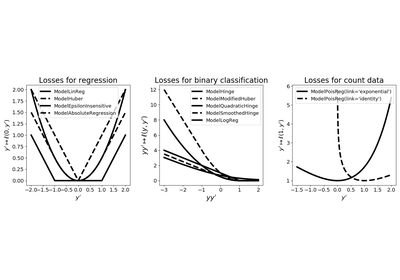tick.robust.ModelHuber¶
-
class
tick.robust.ModelHuber(fit_intercept: bool = True, threshold: float = 1, n_threads: int = 1)[source]¶ Huber loss for robust regression. This model is particularly relevant to deal with datasets with outliers. The class gives first order information (gradient and loss) for this model and can be passed to any solver through the solver’s
set_modelmethod.Given training data \((x_i, y_i) \in \mathbb R^d \times \mathbb R\) for \(i=1, \ldots, n\), this model considers a goodness-of-fit
\[f(w, b) = \frac 1n \sum_{i=1}^n \ell(y_i, b + x_i^\top w),\]where \(w \in \mathbb R^d\) is a vector containing the model-weights, \(b \in \mathbb R\) is the intercept (used only whenever
fit_intercept=True) and \(\ell : \mathbb R^2 \rightarrow \mathbb R\) is the loss given by\[\begin{split}\ell(y, y') = \begin{cases} \frac 12 (y' - y)^2 &\text{ if } |y' - y| \leq \delta \\ \delta (|y' - y| - \frac 12 \delta) &\text{ if } |y' - y| > \delta \end{cases}\end{split}\]for \(y, y' \in \mathbb R\), where \(\delta > 0\) can be tuned using the
thresholdargument. Data is passed to this model through thefit(X, y)method where X is the features matrix (dense or sparse) and y is the vector of labels.- Parameters
fit_intercept :
boolIf
True, the model uses an interceptthreshold :
float, default=1.Positive threshold of the loss, see above for details.
- Attributes
features : {
numpy.ndarray,scipy.sparse.csr_matrix}, shape=(n_samples, n_features)The features matrix, either dense or sparse
labels :
numpy.ndarray, shape=(n_samples,) (read-only)The labels vector
n_samples :
int(read-only)Number of samples
n_features :
int(read-only)Number of features
n_coeffs :
int(read-only)Total number of coefficients of the model
n_threads :
int, default=1 (read-only)Number of threads used for parallel computation.
if
int <= 0: the number of threads available on the CPUotherwise the desired number of threads
-
__init__(fit_intercept: bool = True, threshold: float = 1, n_threads: int = 1)[source]¶ Initialize self. See help(type(self)) for accurate signature.
-
fit(features, labels)[source]¶ Set the data into the model object
- Parameters
features : {
numpy.ndarray,scipy.sparse.csr_matrix}, shape=(n_samples, n_features)The features matrix, either dense or sparse
labels :
numpy.ndarray, shape=(n_samples,)The labels vector
- Returns
output :
ModelHuberThe current instance with given data
-
get_lip_best() → float¶ Returns the best Lipschitz constant, using all samples Warning: this might take some time, since it requires a SVD computation.
- Returns
output :
floatThe best Lipschitz constant
-
get_lip_max() → float¶ Returns the maximum Lipschitz constant of individual losses. This is particularly useful for step-size tuning of some solvers.
- Returns
output :
floatThe maximum Lipschitz constant
-
get_lip_mean() → float¶ Returns the average Lipschitz constant of individual losses. This is particularly useful for step-size tuning of some solvers.
- Returns
output :
floatThe average Lipschitz constant
-
grad(coeffs: numpy.ndarray, out: numpy.ndarray = None) → numpy.ndarray¶ Computes the gradient of the model at
coeffs- Parameters
coeffs :
numpy.ndarrayVector where gradient is computed
out :
numpy.ndarrayorNoneIf
Nonea new vector containing the gradient is returned, otherwise, the result is saved inoutand returned- Returns
output :
numpy.ndarrayThe gradient of the model at
coeffs
Notes
The
fitmethod must be called to give data to the model, before usinggrad. An error is raised otherwise.
-
loss(coeffs: numpy.ndarray) → float¶ Computes the value of the goodness-of-fit at
coeffs- Parameters
coeffs :
numpy.ndarrayThe loss is computed at this point
- Returns
output :
floatThe value of the loss
Notes
The
fitmethod must be called to give data to the model, before usingloss. An error is raised otherwise.
-
loss_and_grad(coeffs: numpy.ndarray, out: numpy.ndarray = None) → tuple¶ Computes the value and the gradient of the function at
coeffs- Parameters
coeffs :
numpy.ndarrayVector where the loss and gradient are computed
out :
numpy.ndarrayorNoneIf
Nonea new vector containing the gradient is returned, otherwise, the result is saved inoutand returned- Returns
loss :
floatThe value of the loss
grad :
numpy.ndarrayThe gradient of the model at
coeffs
Notes
The
fitmethod must be called to give data to the model, before usingloss_and_grad. An error is raised otherwise.
